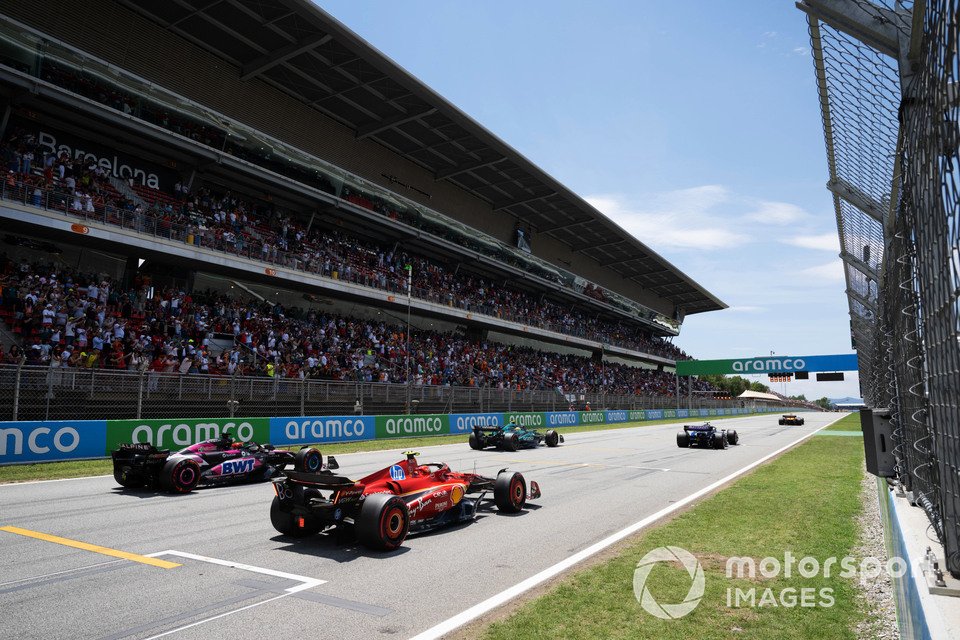
THE “STRANGE” TYRE DELTA THAT OPENS DOOR FOR F1 SPANISH GP STRATEGY INTRIGUE
Potential pre-race showers, a powerful undercut and a soft tyre that is fast but fragile have opened the door for some strategy intrigue in Formula 1’s Spanish Grand Prix.
Rather than the high degradation circuit pushing teams and drivers to go conservative with a boring one-stopper, what is unfolding at Barcelona could trigger plenty of action – and even some aggressive three-stoppers.
That is because the lap-time delta between the three compounds that F1 tyre supplier Pirelli has brought means that the preferred race tyre is actually the soft – even though it is acknowledged to effectively be a one-lap qualifying tyre.
The hard, which is the C1 compound, has been taken off the table as a preferred option because it is not delivering much pace.
Instead, the soft (C3) is so much better in lap time terms – up to 1.2 seconds per lap quicker than the medium, and around 1.8 seconds up on the hard.
As Pirelli chief engineer Simone Berra said: “It [the C1] is more thermally resilient, but it's quite slow compared to the C2 and C3 basically... so the C1 will not really be used. We don't see an advantage from using the C1.
“We know that the C3 is a one-lap tyre, but anyway it is providing a much higher grip level compared to C2. And this means that on longer stints, while degrading, it is faster than the C2 over a stint – even though it is becoming slower.”
The characteristics that are likely to push teams towards the highest degrading tyre tee up an afternoon where looking after the tyres will be critical – but exploiting the undercut could be the name of the game.
With the fastest strategy on paper looking like a soft/medium/soft, Pirelli’s head of F1 and car racing Mario Isola reckons that a one-stopper is off the cards because the soft holds such an advantage – despite its limitations.
“The advantage that you have on pace is clearly what we believe is pushing the teams to choose the soft at the start of the race,” he said.
“It seems maybe a bit strange, because with a heavy car with a full tank obviously you increase the level of degradation. But in terms of a medium/hard strategy [for a one-stop], the level of management is so high that is not convenient. Basically, you lose a lot of time.
“Here, it is also possible to overtake so there is no reason to manage the pace so much to try to go on a one-stop.
“It's also true that if the level of degradation of the soft is higher than expected, it could be a three-stop. In time terms, three-stop is closer to the two-stop than compared to one stop. So if there is a choice, it's probably between two and three, not one and two.”
Tyres
Photo by: Erik Junius
Rain impact
The possibility of teams getting themselves on the front foot and chasing an aggressive three-stop could be increased if the rubber laid down so far this weekend is washed away by rain showers expected before the start.
Isola added: “If it rains and we have a green track, we accelerate the wear, for sure.
“The cars will slide more, and they will wear especially the front left quite a lot on the outside shoulder. They will have to pay attention to that with a green track, and I can imagine that this effect is accelerated.”
All these factors come together to make the timing around pit stop windows critical, as drivers will be looking to exploit the undercut – and make use of any tyre performance advantage to get past rivals who are enduring worn rubber.
Isola added: “The undercut is powerful because the degradation is quite high, so someone could try to use it because it is possible to overtake.
“With a fresh tyre, you can try to do something different from the others. It's also true that if someone stops early, then we know that all the others are just copying the strategy.”
For a Spanish GP venue that in the past was known as being almost impossible to overtake on, expectations are of some intense action – and passing – this time around.
As Mercedes driver George Russell said: “I don't think it will be that difficult to overtake because there is a lot of tyre degradation here.
“You've only got to offset yourself by two or three laps and suddenly, just in the tyre, you'll probably have four tenths advantage on the driver you're battling.
“So ultimately, the quickest driver will nine times out of 10 win the race. It's not like a Singapore or Monaco that if you find yourself in the lead, you can defend it no matter how slow you are.”
2024-06-23T09:56:15Z dg43tfdfdgfd